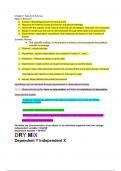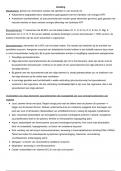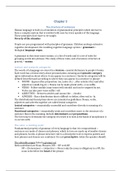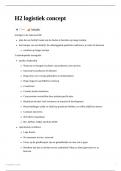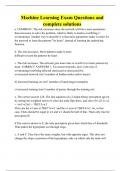Summary
Week 1
Business-to-business (B2B) markets commonly deliver their products directly to other private
companies, governmental agencies, or public organisations. Example B2B installed base:
machines for internal use.
Value/supply chains are combinations of companies that produce, distribute, and eventually
deliver products to the end user.
10 characteristics of B2B relationships:
1. The Pareto principle means that 20% of their customers are good for 80% of their
revenues.
2. Power in the value chain: the power usually lies with the customer, unless they highly
depend on their supplier.
3. Growing interdependencies: B2B companies depend on each other’s unique
resources. Making the relationship more and more complicated.
4. Intensive relationships: the relationships based on collaborative exchanges have a
long-term nature.
5. Multiple source supplier ship: they use multiple suppliers to reduce risks.
6. Industry 4.0: this can be seen as the ‘fourth industrial revolution’. Digital technologies
have changed industrial B2B markets dramatically.
7. Ambidexterity: to be competitive and offer the best value, companies must manage
both the benefits and sacrifices for their customer.
8. From acquisition to retention: there is no massive growth anymore, so companies
started focussing on retaining existing customers.
9. From volume and market share to profitability: in B2B markets where the fixed costs
are low, it is not important to have the most revenues possible. It is more important to
generate revenues and retain customers that contribute to the company’s profitability.
10. Commoditisation in markets: the speed and intensity of becoming a commodity
depends on the actual situation of the dynamics. Commodity trap: the product and
, value are the same as the competitor, so you have to compete on price. To do this,
companies usually go up the value ladder.
Value ladder:
Creating value through customer value marketing
(CVM):
Approach: designing, organising, branding, and
delivering a superior value to the targeted customer
segments the company want to serve. The
customer value propositions are in line with their
value for the company and the value desired by
these customers.
Result: this is to make sure that these customers
experience a superior value, are satisfied/delighted,
have a trust-based relationship, and are committed
and loyal toward the supplier. This eventually to be The 2-bundles customer value proposition framework
financially successful in the long run as a supplier
and it contributes to the shareholder value.
, B2C situations are supported by B2B processes. The processes need to be integrated to
enable what has been promised and agreed upon in the B2B marketing to satisfy the buyers.
Week 2
The value for the supplier is getting revenue
and profits, social versus the cost of/investment
in the products delivered. The value for the
customer is getting products, social versus the
price of/total cost to pay/invest. A good value
exchange is like a marriage.
The value of the customer (VOC) can be based
on four elements:
1. Direct financial
Including: revenue & potential, buying patterns, customer profitability, customer lifetime
value, and risks.
Buying patterns:
• LBD model
Length: duration of the relationship.
Breadth: different products the customer buys (cross-buying).
Depth: our share in the customer’s wallet.
Profitability:
• Strobachoff curve
• The profitability matrix
2. Indirect financial
Including: ambassadorship (word-of-mouth
(WOM) and active referrals), flagship effect, and
customer knowledge.
3. Relational
Including: compatibility, communication & openness, and trust & commitment
(outcomes).
4. Sustainability
Including: contribution to supplier’s sustainability goals.
Week 1
Business-to-business (B2B) markets commonly deliver their products directly to other private
companies, governmental agencies, or public organisations. Example B2B installed base:
machines for internal use.
Value/supply chains are combinations of companies that produce, distribute, and eventually
deliver products to the end user.
10 characteristics of B2B relationships:
1. The Pareto principle means that 20% of their customers are good for 80% of their
revenues.
2. Power in the value chain: the power usually lies with the customer, unless they highly
depend on their supplier.
3. Growing interdependencies: B2B companies depend on each other’s unique
resources. Making the relationship more and more complicated.
4. Intensive relationships: the relationships based on collaborative exchanges have a
long-term nature.
5. Multiple source supplier ship: they use multiple suppliers to reduce risks.
6. Industry 4.0: this can be seen as the ‘fourth industrial revolution’. Digital technologies
have changed industrial B2B markets dramatically.
7. Ambidexterity: to be competitive and offer the best value, companies must manage
both the benefits and sacrifices for their customer.
8. From acquisition to retention: there is no massive growth anymore, so companies
started focussing on retaining existing customers.
9. From volume and market share to profitability: in B2B markets where the fixed costs
are low, it is not important to have the most revenues possible. It is more important to
generate revenues and retain customers that contribute to the company’s profitability.
10. Commoditisation in markets: the speed and intensity of becoming a commodity
depends on the actual situation of the dynamics. Commodity trap: the product and
, value are the same as the competitor, so you have to compete on price. To do this,
companies usually go up the value ladder.
Value ladder:
Creating value through customer value marketing
(CVM):
Approach: designing, organising, branding, and
delivering a superior value to the targeted customer
segments the company want to serve. The
customer value propositions are in line with their
value for the company and the value desired by
these customers.
Result: this is to make sure that these customers
experience a superior value, are satisfied/delighted,
have a trust-based relationship, and are committed
and loyal toward the supplier. This eventually to be The 2-bundles customer value proposition framework
financially successful in the long run as a supplier
and it contributes to the shareholder value.
, B2C situations are supported by B2B processes. The processes need to be integrated to
enable what has been promised and agreed upon in the B2B marketing to satisfy the buyers.
Week 2
The value for the supplier is getting revenue
and profits, social versus the cost of/investment
in the products delivered. The value for the
customer is getting products, social versus the
price of/total cost to pay/invest. A good value
exchange is like a marriage.
The value of the customer (VOC) can be based
on four elements:
1. Direct financial
Including: revenue & potential, buying patterns, customer profitability, customer lifetime
value, and risks.
Buying patterns:
• LBD model
Length: duration of the relationship.
Breadth: different products the customer buys (cross-buying).
Depth: our share in the customer’s wallet.
Profitability:
• Strobachoff curve
• The profitability matrix
2. Indirect financial
Including: ambassadorship (word-of-mouth
(WOM) and active referrals), flagship effect, and
customer knowledge.
3. Relational
Including: compatibility, communication & openness, and trust & commitment
(outcomes).
4. Sustainability
Including: contribution to supplier’s sustainability goals.



